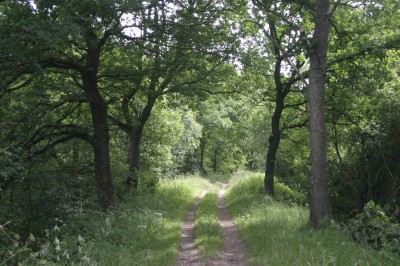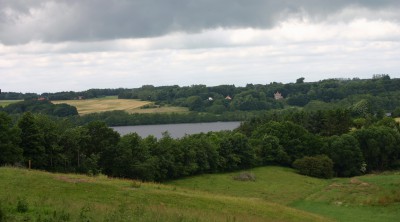In the first summer months of 2016, I resume my
project of walking all the way up through Jutland.
Once again, I have my friend Niels for company. Last year we ended in the southern
part of Jutland, just north of where the old border to Germany used to be.
We left off in Læborg, at a white church in front of
which was a big stone with runes engraved on it. This year we start in Bække, five
kilometres north of that church, at another white church with a big stone with
runes on it. This stone is from about 925 AD and is yet another reminder that
this historical route has been used since the days of the Vikings. 
Runes and rocks, stone and ships
On our journey northwards we come upon an even more
ancient monument at a place called Klebæk Høje. This spot is 81 metres above
sea level so it has afforded good views of the surrounding area throughout the
ages.
On this spot there are two burial mounds dating back
to the Bronze Age (3,500 years ago). Later on, about 1,100 years ago, an
important Viking woman was buried here. She was honoured with a stone ship.
This was a custom in which the burial or cremation area was surrounded by stone
slabs that formed the shape of a ship. Historians figure that these ships were
constructed to provide the dead person with means of transport to the next
world. This particular stone ship is 45 m long. One of the Bronze Age burial
mounds is at the helm of the ship while a big stone with runes engraved on it marks
the other end of the stone ship. 
The historical Hærvejen – the road that we are
following up though Jutland – cuts right through the ship, leaving a 10 m wide swathe
that has worn down into the ground.
Not far from the stone ship we come upon another
interesting rock – the Hamborggårdstenen. This 50 ton boulder was transported
at the front edge of a glacier during the Ice Age and left behind when the
glacier receded. It came from Ålandsøerne, which is a group of Finnish islands
snuggled between Finland and Sweden. The glacier pushed the block of stone for
hundreds of kilometres about 20,000 to 25,000 years ago. Neat, eh? 
Then along came the Viking Harald Bluetooth (not the man in the photo – that’s Niels). He wanted
to drag the boulder to his mother’s grave in Jelling (you will hear more about
Jelling later on). I don’t know if he would have succeeded, but he abandoned
the project when he learned that his son Svend Forkbeard was plotting to depose
him as king. 
I’ll get back to Harald Bluetooth and his parents
later on, when I reach Jelling. In the meantime, Niels and I wander through the
attractive Danish summer landscape.  I think it is best at this time of year,
I think it is best at this time of year,
i.e. late spring and early summer. Along the way, we see idyllic country homes
with thatched rooves. 
 We see deer and hares, cattle and cows, free-range pigs, vineyards, and fields with barley, rapeseed, wheat and rye before reaching the southern outskirts of the town of Jelling.
We see deer and hares, cattle and cows, free-range pigs, vineyards, and fields with barley, rapeseed, wheat and rye before reaching the southern outskirts of the town of Jelling. 




